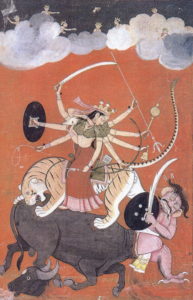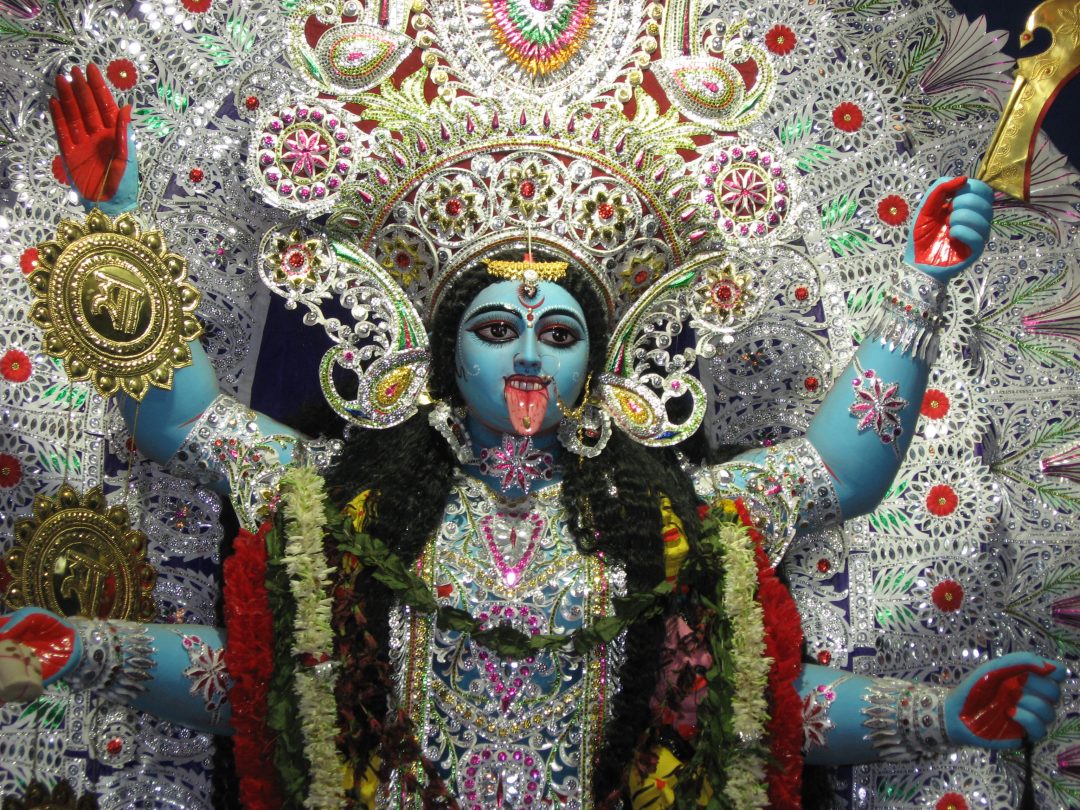Kali, a female goddess, is an aspect of the goddess Devi, who can function separately from Devi or be absorbed by Devi. Kali is therefore subordinate and represents one aspect or talent of Devi.
Devi represents omnipotence and creation and destruction of the universe
For perspective, Devi represents omnipotence and creation and destruction of the universe. As a cosmic force, Devi is associated with championing the world when it comes to the threat posed by demonic forces. Devi is seen as a restorer of stability and balance for the planet. Devi’s omnipotence is depicted in having multiple forms and multiple arms. Devi carries various weapons, symbolically stating her readiness and ability to divide her attention on multiple battlefronts when necessary. Some of her forms include Durga, Kali, Chamunda (Kali renamed), and herself as Devi.
 Goddess Kali is associated with the darker, warring side of Devi. The third story of the “Devi Mahatmya” describes Kali’s emergence from Devi’s forehead as a fiery, bursting of focused dark power.
Goddess Kali is associated with the darker, warring side of Devi. The third story of the “Devi Mahatmya” describes Kali’s emergence from Devi’s forehead as a fiery, bursting of focused dark power.
The goddess Kali is commonly depicted as emaciated, black, and with a skull bone necklace. Devi, in the form of Kali, is also rendered in art as a symbolic matron of the universe in a deep blue form of a “void” that evokes fear of darkness, apprehension of the unknown and the future, and even exhilaration and celebration. Such a rendering serves to emphasize the power and allure of Kali.
Kali wins the name “Chamunda” from Devi when she overpowers the two demon generals Chanda and Munda, bringing their severed heads back to Devi.
Kali, as one aspect of Devi’s powers, is depicted in a painting, “Kali Drinks the Blood of Raktabija,” lent by Mr. and Mrs. John Gilmore Ford to the Smithsonian Institute. Kali is depicted as a nude black female with freely hanging breasts in battle, drinking the blood of Raktabija, in compliance with a request of Devi to contain him. Mention is made of her large mouth and long tongue, which are successfully employed to contain the further spread of demons sprouting from the blood of Raktabija and falling to the earth below. Kali is thus represented as an able talent of Devi, able to function apart from Devi, and competently saving the world from further destruction by a demonic force. The success of Kali is also a manifestation of the omnipotence and ability of Devi herself.
Another story involves Devi, Kali and others destroying two demons Shumbha and Nishumbha, who are brothers. Ultimately, Devi absorbs all her other forms, including Kali, and finishes the battle standing alone.






